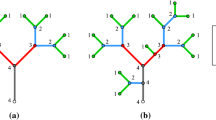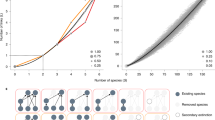Abstract
We investigated the structural correlates of stability and resilience in strong hierarchies, that is, systems that can be represented by a rooted tree. A simple exponential model that incorporates three variables (the total number of nodesN; the number of basal nodesn B; and the number of single links among nodesN 1) accounts for 95% of the observed variability in stability among trees in our sample population. For resilience the situation is even simpler, with about 89% of the population variation being accounted for by tree size (N). For strong hierarchies, size and shape are the principal correlates of stability, while size alone explains the major proportion of the variability in resilience among stable trees. These results suggest that reasonably accurate statistical predictions about the stability and resilience of strong hierarchies can be made from a small set of (relatively) easily measured variables, without detailed knowledge of system topology.
Similar content being viewed by others
Literature
Allen, T. H. F. and T. B. Starr. 1982.Hierarchy: Perspectives for Ecological Complexity. Chicago, U.S.A.: University of Chicago Press.
Austin, P. M. and B. G. Cook. 1974. Ecosystem stability: a result from an abstract simulation.J. theor. Biol. 45, 435–458.
Bachas, C. P. and B. A. Huberman. 1986. Complexity and the relaxation of hierarchical structures.Phys. Rev. Lett. 57, 1965–1969.
Bachas, C. P. and B. A. Huberman. 1987. Complexity and ultradiffusion.J. Phys. A: Math. Gen. 20, 4995–5014.
Bandelt, H.-J. and A. Dress. 1989. Weak hierarchies associated with similarity measures—an additive clustering technique.Bull. math. Biol. 51, 133–166.
Bonner, J. T. 1980.The Evolution of Complexity. Princeton, U.S.A.: Princeton University Press.
Busacker, R. G. and T. L. Saaty. 1969.Finite Graphs and Networks: An Introduction with Applications. New York: McGraw-Hill.
Ceccatto, H. A. and B. A. Huberman. 1988. The complexity of hierarchical systems.Phys. Scripta 37, 145–150.
Cohen, J. E., F. Briand and C. M. Newman. 1990.Community Food Webs: Data and Theory. New York: Springer-Verlag.
Gillespie, D. T. 1975.The Monte Carlo Method for Evaluating Integrals. Springfield: National Weapons Center Technical Publication 5714.
Hogg, T., B. A. Huberman and J. M. McGlade. 1989. The stability of ecosystems.Proc. R. Soc. Lond. B237, 43–51.
Huberman, B. A. (Ed) 1988.The Ecology of Computation. Amsterdam: North-Holland Publishing.
Huberman, B. A. and T. Hogg. 1988. Complexity and adaptation.Physica D22, 376–384.
May, R. M. 1974.Stability and Complexity in Model Ecosystems. Princeton, U.S.A.: Princeton University Press.
May, R. M. 1983. Ecology—the structure of food webs.Nature 301, 566–568.
McMorris, F. R. and R. C. Powers. 1991. Concensus weak hierarchies.Bull. math. Biol. 53, 679–684.
McMurtie, R. F. 1975. Determinants of stability of large, randomly-connected systems.J. theor. Biol. 40, 1–11.
O'Neill, R. V., D. L. DeAngelis, J. B. Waide and T. F. H. Allen. 1986.A Hierarchical Concept of Ecosystems. Princeton, U.S.A.: Princeton University Press.
Pattee, H. 1973.Hierarchy Theory: The Challenge of Complex Systems. New York: George Braziller.
Pimm, S. L. 1984. The complexity and stability of ecosystems.Nature 307, 321–326.
Pimm, S. L., J. H. Lawton and J. E. Cohen. 1991. Food web patterns and their consequences.Nature 350, 669–674.
Rammal, R., G. Toulouse and M. A. Virasoro. 1986. Ultrametricity for physicists.Rev. Mod. Phys. 58, 765–788.
Simon, H. 1962a.The Sciences of the Artificial. Cambridge, MA: MIT Press.
Simon, H. 1962b. The architecture of complexity.Proc. Am. Phil. Soc. 106, 476–482.
Author information
Authors and Affiliations
Rights and permissions
About this article
Cite this article
Findlay, S., Zheng, L. Structural correlates of stability and resilience in strong hierarchies. Bltn Mathcal Biology 55, 543–560 (1993). https://doi.org/10.1007/BF02460650
Received:
Revised:
Issue Date:
DOI: https://doi.org/10.1007/BF02460650




